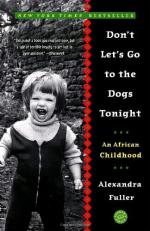
|
| Name: _________________________ | Period: ___________________ |
This test consists of 15 multiple choice questions and 5 short answer questions.
Multiple Choice Questions
1. What did Bobo pray for with the missionaries in Chapter 14: "Missionaries 1975"?
(a) The health of a sick relative.
(b) A baby brother or sister.
(c) Peace for her country.
(d) A boyfriend.
2. What animal did the narrator’s mother shoot in Chapter 12: "Dog Rescue"?
(a) A baboon.
(b) A crocodile.
(c) A cobra.
(d) An elephant.
3. In what year did Rhodesian President Ian Douglas Smith make it clear that there would never be majority rule in Rhodesia?
(a) 1953.
(b) 1965.
(c) 1972.
(d) 1978.
4. Where in England did the Fullers buy a farm?
(a) Salisbury.
(b) Exeter.
(c) Derbyshire.
(d) Cardiff.
5. What is the name of Bobo’s brother who died of meningitis before she was born?
(a) Robert Fuller.
(b) Tim Fuller.
(c) Adrian Fuller.
(d) Richard Fuller.
6. To what town did the Fullers move in Rhodesia before settling in Karoi?
(a) Mgodi.
(b) Dete.
(c) Cape Town.
(d) Chirundu.
7. During Kenya’s war for independence, how many black Kenyans were killed, according to the narrator in Chapter 3: "Chimurenga I: Zambia, 1999"?
(a) 13,000.
(b) 25,000.
(c) 49,000.
(d) 77,000.
8. What did the narrator’s mother see that caused her to put down her gun when the missionaries visited in Chapter 14: "Missionaries 1975"?
(a) Their coats.
(b) Their hats.
(c) Their Bibles.
(d) Their crosses.
9. In what year was Alexandra Fuller born?
(a) 1948.
(b) 1976.
(c) 1969.
(d) 1937.
10. How many dogs accompanied the narrator, her mother, and her sister in traveling to Rhodesia in Chapter 7: "England 1969"?
(a) 5.
(b) 2.
(c) 3.
(d) 7.
11. After going to the sale barn, the narrator’s family stayed with a friend who had what in Chapter 20: "Selling”?
(a) A horse.
(b) An elephant.
(c) A radio.
(d) A television.
12. What students attended the B schools?
(a) Mixed-race and Indian students.
(b) Black students.
(c) American students.
(d) White students.
13. Vanessa was older than Bobo by how many years?
(a) 4.
(b) 6.
(c) 1.
(d) 3.
14. During Kenya’s war for independence, how many white settlers were killed, according to the narrator in Chapter 3: "Chimurenga I: Zambia, 1999"?
(a) 240.
(b) 420.
(c) 100.
(d) 65.
15. What color hair did Bobo have as a child?
(a) Blonde.
(b) Red.
(c) Brown.
(d) Black.
Short Answer Questions
1. The narrator states in Chapter 10: "Chimunenga 1974" that the black Africans had been fighting a revolution against whites for how many years?
2. What did the narrator’s mother offer to the medics before they left in Chapter 19: "Violet"?
3. In Chapter 17: "Vacation,” Bobo exclaimed over the fact that the black Africans did not use modern farming methods of what?
4. What did the narrator’s mother do when it was time to kill the rabbits on the farm for food in Chapter 7: "England 1969"?
5. In Mum's view, an African country controlled by whites was considered what?
|
This section contains 441 words (approx. 2 pages at 300 words per page) |

|




